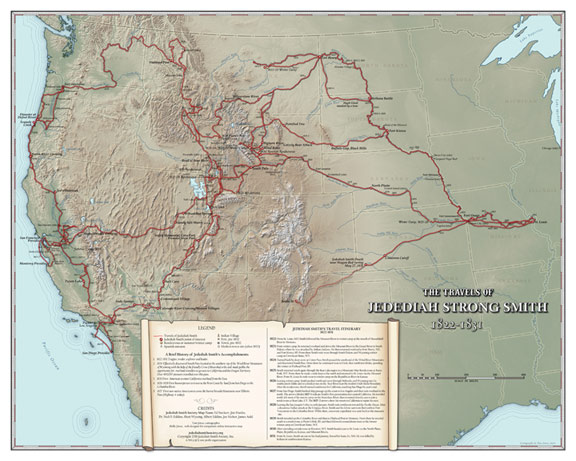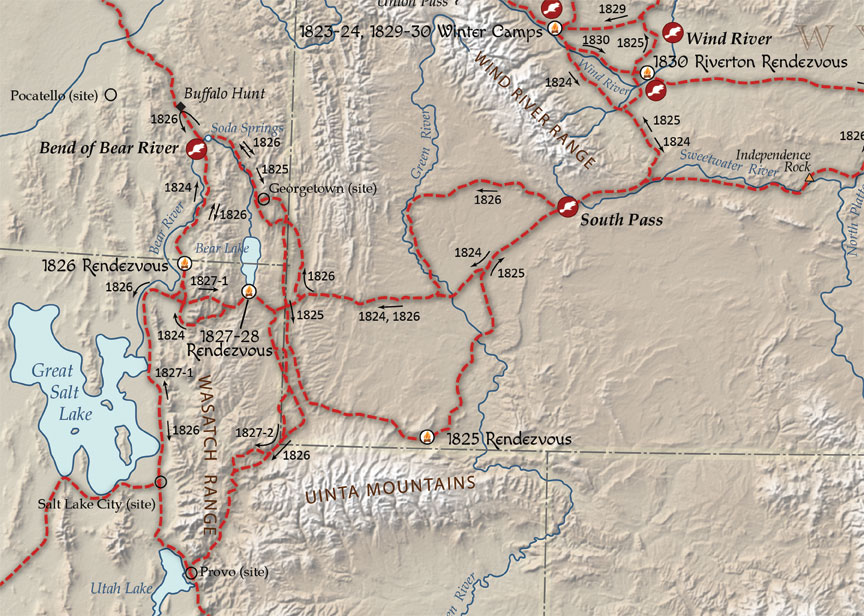Interactive Maps
Guidelines for Use of the Interactive Digital Maps


Enlarged example of a regionalized view.
Map of the Travels of Jedediah Strong Smith 1822-1831
- 1822-1831 Trapper, Trader, Explorer and Leader.
- 1824 Effectively discovered South Pass located at the southern tip of the Wind River Mountains of Wyoming with the help of the friendly Crow (Absaroka) tribe and made public the opportunity for overland travelers to go west to California and the Oregon Territory. Over 400,000 pioneers travelled over this pass.
- 1826 First American to enter California overland from the East.
- 1826-1828 First known person to traverse the West Coast by land from San Diego to the Columbia River.
- 1827 First non-native American to Cross the Sierra Nevada Mountains near Ebbetts Pass (Highway 4 today).
How to Use the Maps
The maps were drawn by Jedediah Smith Society Map experts and historians who have researched the routes and travelled much of the area Smith journeyed. The maps are based on the primary source journals, historic maps, and other publications which are referenced at the end of this guideline. It is broken into the following areas:
Mississippi West to Wyoming, Kansas Utah and Nevada California Oregon and WashingtonViewing the Interactive Maps
1. When you open the desired interactive map, you will see one or more overview maps of a portion of Jedediah Smith’s travels, divided by location and date.
You may zoom in and out on the overview maps with the (+) and (–) boxes in the corner or just hold the Ctrl key and roll the scroll wheel on your mouse.
The map may be clicked and dragged to move around while zoomed in. Note: On some trail maps that cover a very large area, the trail overview may not be apparent in the initial overview. In that case, zoom out (–) until the trail becomes visible.
2. To view the map full screen, click the “View Full-Size Route” button below the overview map. The map will open in a new tab in your browser.
3. Beaver Icons mark points of interest on the trail. Click on this icon to display a brief summary of the location. It may also include a photograph. Double clicking on the picture will give you a full screen view of that photo plus give you the opportunity to view a second photo if such a photo is present.
4. Directional arrows indicate the direction of travel on the current path. Star symbols indicate which maps show Smith’s travels immediately before and after the current map.
5. When done viewing a full-screen map, simply close its browser tab by clicking the (x) on the tab at top.
These maps are drawn to the best knowledge we have at present.
There are only 2 surviving portions of Jedediah Smith’s journals which detail the Southwest portion up to the Umpqua in Oregon. Other journals and maps, and references have been used to document the lines. Even with the journals, the lines you will see are an interpretation from careful studies of the manuscripts, books, maps, journals, topography and satellite data. Members of the Jedediah Smith Society have personally followed most of these routes on the ground to verify their agreement with the available data.
Comments
Feel free to leave a comment on the space provided at right if you have a question or suggestion. Please leave 15 days for a response. Your email will not show on the web site.
References
The following major references have been consulted to make this map and also may be used for further research:
Books and Journals
1. Morgan, Dale L. 1953. Jedediah Smith and the Opening of the West
2. Wheat, Carl, & Dale Morgan 1954. Jedediah Smith, and His Maps of the American West.
3. Sullivan, Maurice S. 1934, The Travels of Jedediah Smith; A Documentary Outline, Including His Journal. (1827-28)
4. Brooks, George R. 1977. The Southwest Expedition of Jedediah S. Smith; His Personal Account of the Journey to California, 1826-27.
and H. G. Dale
5. Rogers, Harrison G. 1977. Daybook 1. Included in Brooks and H.G Dale
6. McLeod, Alex R. Journal of the Southern Expedition. Two portions of his Journals which cover the period of September 6 to December 10, 1828, included in Sullivan
7. Dale, Harrison C. 1917, The Ashley-Smith Explorations and the Discovery of a Central Route to the Pacific 1822-1829.
Maps
1. Brue, A. H, 1833. Nouvelle Carte de l’ Amerique septentrionale. First published map depicting any of Jedediah Smith’s routes=Smith’s Southwest Expedition.
2. Burr, David. 1839. Map of the United States of North America with Some Parts of the Adjacent Countries, (First published map extensively depicting Jedediah Smith’s routes)
3. Gibbs, George 1843. Fremont -Gibbs- Smith map. Detailed routes with descriptions of places along the trail.
4. Wheat Carl, & Dale Morgan 1954. Jedediah Smith, and His Maps of the American West. Includes, Brue, Burr and Gibbs maps. These maps are published in the book. A folded copy of the two maps is placed in an envelope on the back inside cover of his book.
5. Morgan, Dale L. 1953. Jedediah Smith and the Opening of the West. Includes a map entitled The Travels of Jedediah Smith in the West 1822-1831. Drawn by Dale Morgan.
6. Wilkes, Charles, 1849 Map of Upper California
An Introduction to the Map
By Sheri Wysong, Jedediah Smith Society
Jedediah Smith arrived in the Rocky Mountains in 1822, as a fur trapper in the employ William Ashley and Andrew Henry. In the years, his travels around and west of the Continental Divide resulted in actions that led to, as Historian Dale Morgan put it, “The Opening of the West.” Smith’s rediscovery of the South Pass of the Continental Divide and of the inhospitable nature of the Great Basin desert shaped the pathways of hundreds of thousands of emigrants from the eastern United States to the Oregon Territory and later to Utah and California.
Smith’s travels, however, were much more extensive, travels that he described in a March 2, 1831 to the Secretary of War John H. Eaton. Smith wrote: “I have traveled from the mouth of the Missouri River nearly to the great Falls at different times. The Big Platte and the Yellow Stone Rivers I have more than once traced from their Mouths to the sources and have made Journeys in many directions through the extensive country in which the Missouri has numerous sources. From the waters of the Missouri I have traveled twice to California a part of which routes were along the Colorado of the West. From the valley of the Buenaventura1 which discharges its waters into the Bay of St. Francisco I have traveled across the Sand Plain to the Great Salt Lake. With the country in the vicinity of the Lake I am familiar. From the Bay of St. Francisco alternately on the sea coast and through the interior I traveled to the Columbia River discovering some considerable rivers south of the Columbia. The Multnomah River2 I have traced through it course. From the mouth of the Columbia I followed its course to the source of its principle branch and in the mountains on the heads of the several tributaries of the Columbia I have traveled in many directions acquiring a knowledge of nearly all the passes between the waters of the Missouri and the Columbia and Colorado of the West” (Smith 2001, 5)
Smith went on to write: “I have a Map just finished which combines all the information I have personally collected with all that was before known of our Western Territory. I have also notes of my travels.” Smith’s map and notes have long been missing, but before they disappeared they were used as the source of several published maps and Smith’s memoirs, which were found in two pieces, the first one in the 1920 by Smith biographer Maurice Sullivan, and the other by a descendant of Ashley’s lawyer in 1967. From these maps, the memoir and the journals of Smith’s contemporaries, Smith’s routes during his nearly nine years west of St. Louis can be conjectured with varying degrees of accuracy.
Some segments of Smith’s routes can be depicted very accurately if say, Smith followed or traveled on a particular river, or described traveling in easily identified canyons. But, most of Smith’s overland travels can only be conjectured from descriptions of landmarks along the way. The maps drawn for this project are based on the best postulates of their creators, based on their knowledge of the geography and topography of the region. Published maps derived from Smith’s maps provide clues, as does the Frémont-Gibbs-Smith map; an 1844 published map of John Charles Frémont’s travels upon which ethnographer George Gibbs annotated Smith’s map in the early 1850’s. These maps are described in The Maps of Jedediah Smith in the American West, published by Carl Wheat and Dale Morgan in 1954.
The takeaway of these maps is not to try to assert the exact routes Smith traveled, but to put his travels into the historical context of events that took place before or after his presence, providing on overview of Smith’s place in “The Opening of the West.”
[1] The Sacramento River Valley
[2] Willamette River
